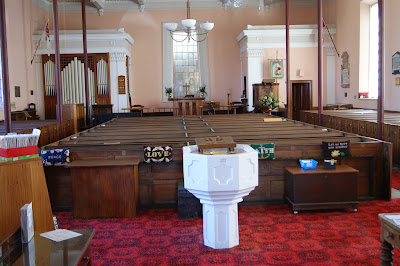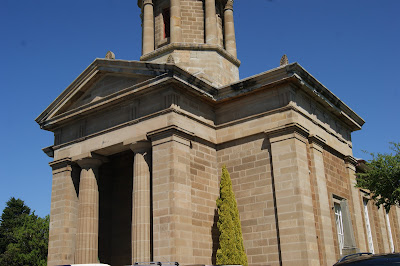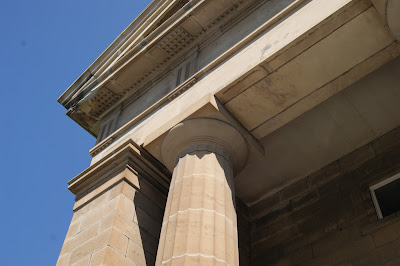At the time, most of the land in Battery Point to the south of Hampden Road was owned by William Kermode and he sold the church trustees a hilltop site on the southern side of Cromwell Street for 250 pounds. The church design was completed by John Lee Archer and tenders from “persons desirous of contracting for the immediate erection and completion of the church” were called for in May 1836.
The ceremonial foundation stone was laid by Lieutenant Governor George Arthur in October 1836. The site was described as having a commanding eminence and it was predicted that the church would present a cheering and prominent feature in the landscape of Hobart Town.
The church has an unusual layout, with two side aisles instead of a single central aisle. It still has its original cedar box pews. Lack of funds meant that the first phase of construction did not include the tower or the front porch. Nevertheless, the large sandstone church was formally consecrated in May 1838 and the Hobart Town Courier reported that its general characteristics, both externally and internally, were perfect neatness & simplicity.
Having completed the initial work, it was decided in 1841 to proceed with the tower with a design by convict architect, James Blackburn. The Government was asked for assistance, and agreed to grant convict labour, stone and timber, on the basis that the subscribers were to supply cartage, lime, lead and other materials. Work began on building the tower, but it was soon found that the tower basement, which had been put in at the time of the original building, was badly built and insufficient to bear the weight of the tower. It was found necessary to remove this basement, as well as the vestibule and the two vestries on either side of it. For various reasons, one of which was the inability to supply suitably skilled convict labour, the work was frequently interrupted and left for long periods. By 1847 the tower was finally completed, but the porch and the rooms at the basement of the tower were left unfinished. For five years “the Church was more or less exposed to the weather and great inconveniences were occasioned to the congregation”
The tower construction was associated with even more controversy. John Montagu, the colonial secretary, resided in nearby Stowell and was one of the parishioners at St George’s. Montagu had authorized the expenditure of a large sum of public money for the erection of the tower without the approval of the Lieutenant Governor John Franklin. When Franklin eventually inquired into the matter, Montagu laid the blame of Alexander Cheyne, the director of public works for proceeding without the proper authority and had Franklin sack him. Cheyne protested his innocence but it took another two years before a note proving that it was Montagu, and not Cheyne who had ordered the works, was finally discovered.
At this stage, the church still didn’t have a front porch which was considered all that was necessary to finish the building and render it one of the most beautiful buildings in Hobart Town. Thus a church completion fund was established and by 1888, enough had been raised to allow the construction of the Doric styled portico. Despite being constructed in three stages over some 50 years, the church presents a unified appearance and is considered to be the finest Greek Revival style church in Australia.
In 2013, St Georges Church celebrated its 175th anniversary, celebrating its rich heritage and its continued focus upon serving the community, local and overseas mission, advocacy work and services for worship and fellowship. Erected to serve as a mark for shipping, the tower of St George’s has been a landmark for sailors ever since 1847. Back in the nineteenth century when St George’s was built, Battery Point was home to master mariners, shipwrights, seamen, fishermen, shipping agents and many others who worked in the shipbuilders' yards and on the wharves. These connections earned St George's the name of "The Mariners' Church".
Main Text & Information Sources –
“The Story of Battery Point – Street By Street” – Donald Howatson 2012
Australian Heritage Database
Historical Photos –


















